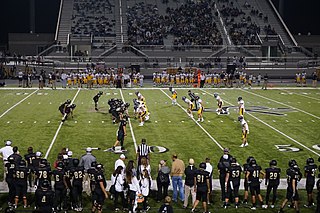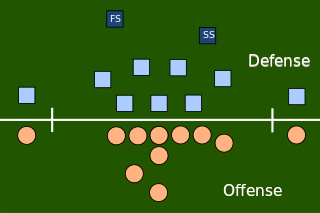Related Research Articles

A running back (RB) is a member of the offensive backfield in gridiron football. The primary roles of a running back are to receive handoffs from the quarterback to rush the ball, to line up as a receiver to catch the ball, and block. There are usually one or two running backs on the field for a given play, depending on the offensive formation. A running back may be a halfback, a wingback, or a fullback. A running back will sometimes be called a "feature back" if he is the team's key player/more prominent running back.

The tight end (TE) is an offensive position in American football, arena football, and Canadian football. It is a hybrid that combines the characteristics and roles of both an offensive lineman and a receiver. As part of the receiver corps, they play inside the flanks (tight), contrasted with the split end who plays outside the flanks (wide). Like offensive linemen, they are usually lined up on the offensive line and are large enough to be effective blockers. On the other hand, unlike offensive linemen, they are eligible receivers and potent weapons in a team's offensive schemes.
American football positions have slowly evolved over the history of the sport. From its origins in early rugby football to the modern game, the names and roles of various positions have changed greatly, some positions no longer exist, and others have been created to fill new roles.

In American football, the pro set or split backs formation is a formation that has been commonly used as a "base" set by professional and amateur teams. The "pro set" formation features an offensive backfield that deploys two running backs aligned side-by-side instead of one in front of the other as in traditional I-formation sets. It was an outgrowth of the three-running-back T-formation, with the third running back in the T becoming a permanent flanker, now referred to as a wide receiver.
A formation in American football refers to the position players line up in before the start of a down. There are both offensive and defensive formations and many in both categories. Sometimes, formations are referred to as packages.

In sports, a starting lineup is an official list of the set of players who will participate in the event when the game begins. The players in the starting lineup are commonly referred to as starters, whereas the others are substitutes or bench players.
The halfback option play is an unorthodox play in American and Canadian football. It resembles a normal running play, but the running back has the option to throw a pass to another eligible receiver before crossing the line of scrimmage.
An H-back is an offensive position in American football. The H-back lines up similarly to a tight end, but is "set back" from the line of scrimmage, and is thus counted as one of the four "backs" in the offensive formation. The H-back, while similar in name, should not be confused with "halfback" or "running back", which are used to denote a separate, primary ball-carrying backfield position. The position was made notable in the National Football League (NFL) by the Washington Redskins under head coach Joe Gibbs, who ran a two tight end system. The position was named F-back when used later in Norv Turner's offensive system. The position is similar to that of a slotback

In American football, a T formation is a formation used by the offensive team in which three running backs line up in a row about five yards behind the quarterback, forming the shape of a "T".

A halfback (HB) is an offensive position in American football, whose duties involve lining up in the offensive backfield and carrying the ball on most rushing plays, i.e. a running back. When the principal ball carrier lines up deep in the backfield, and especially when that player is placed behind another player (usually a blocking back), as in the I formation, that player is instead referred to as a tailback (TB).

In American football, the specific role that a player takes on the field is referred to as their "position". Under the modern rules of American football, both teams are allowed 11 players on the field at one time and have "unlimited free substitutions", meaning that they may change any number of players during any "dead ball" situation. This has resulted in the development of three task-specific "platoons" of players within any single team: the offense, the defense, and "special teams". Within these three separate "platoons", various positions exist depending on the jobs that the players are doing.

Safety (S), historically known as a safetyman, is a position in gridiron football on the defense. The safeties are defensive backs who line up ten to fifteen yards from the line of scrimmage. There are two variations of the position: the free safety (FS) and the strong safety (SS). Their duties depend on the defensive scheme. The defensive responsibilities of the safety and cornerback usually involve pass coverage towards the middle and sidelines of the field. While American (11-player) formations generally use two safeties, Canadian (12-player) formations generally have one safety and two defensive halfbacks, a position not used in the American game.

The flexbone formation is an offensive formation in American football that includes a quarterback, five offensive linemen, three running backs, and varying numbers of tight ends and wide receivers. The flexbone formation is derived from the wishbone formation and features a quarterback under center with a fullback lined up directly behind the quarterback. There are two smaller running backs called slotbacks aligned behind the line of scrimmage on each side of the offensive line. The slotbacks are sometimes incorrectly referred to as wingbacks. But in order to be a wingback, there must be a guard, tackle and tight end all on one side of the center on the line of scrimmage and then the wingback off the line of scrimmage.

The triple option is an American football play used to offer six ways to move the football forward on the field of play. The triple option is based on the option run, but uses three players who might run with the ball instead of the two used in a standard option run.
In American football, a play is a close-to-the-ground plan of action or strategy used to move the ball down the field. A play begins at either the snap from the center or at kickoff. Most commonly, plays occur at the snap during a down. These plays range from basic to very intricate. Football players keep a record of these plays in a playbook.

A fullback (FB) is a position in the offensive backfield in gridiron football and is one of the two running back positions along with the halfback. Fullbacks are typically larger than halfbacks, and, in most offensive schemes, the fullback's duties are split among power running, pass catching, and blocking for both the quarterback and the other running back.
The offensive backfield is an ambiguous generic term of football, which includes: (1) a place, namely the area of an American football field behind the line of scrimmage; and (2) a group classification of certain players positioned there, i.e., members of offense who begin plays behind the line, typically including any backs on the field, such as the quarterback, halfbacks and fullback. There are rules specific to the manner of play in that area.
The following terms are used in American football, both conventional and indoor. Some of these terms are also in use in Canadian football; for a list of terms unique to that code, see Glossary of Canadian football.
In American football, a back is a player who plays off of the line of scrimmage. Historically, the term "back" was used to describe multiple positions on offense and defense, although more descriptive and specific position naming is now common. Thus, "back" can refer to positions including:
References
- ↑ "On-Field Positions, Play and Penalty Terminology Glossary on CFLdb". cfldb.ca.
- ↑ "Football 101 – Offense, Defense, & Special Team positions – CanadaFootballChat.com".
- ↑ "Canadian Football Positions: Explained | TheSportsReviewer.com". thesportsreviewer.com. February 16, 2024.